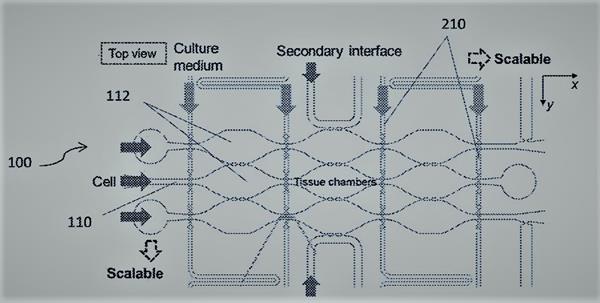Multi Layered Microfluidic Devices For In Vitro Large Scale Perfused Capillary Networks
Brief Description
"Organ-on-a-chip” technologies allow recapitulation of organ systems in vitro and can be utilized for drug response and toxicity studies, which are required in preclinical studies. However, current recapitulations via “organ-on-a-chip” technologies are limited because the designs do not fully reflect physiological complexity. To address this, UC Irvine inventors have developed a device to better mimic the vascular network of the circulatory system. This device can also be used to simulate different tissues, disease models or organs.
Full Description
“Organ-on-a-chip” systems can mimic the characteristics and functions of organs in vitro and thus are useful medical research tools. Using such systems, researchers have been looking for ways to better study the vascular network of the circulatory system. However, current capillary networks recapitulated by “organ-on-a-chip” systems utilize a single layer configuration, limiting the layout, positioning, and complexity of these networks.
Inventors at UC Irvine have devised a flexible and scalable multi-layered microfluidic system for improving the physiological recapitulation of capillary systems. The multi-layer configuration strategy devised by the inventors separates the culture medium and tissue chambers such that the media flows from the medium channels to the tissue chambers (Figure 1). Such a fluid connection of tissue chambers to the medium channels result in the formation of three-dimensional large-scale perfused capillary networks.
This enhancement is important because with the integration of a large-scale functional microvasculature network, researchers can: (1) better study physiological relevant phenomenon such as angiogenesis (sprouting of new vessels), anastomosis (connecting between/among vessels), and perfusion, and (2) perform drug studies on physiologically similar “organ systems”.

Figure 1: Schematic representation (a top view) of a microfluidic system. The system features a two-layered microfluidic device with scalable channels for culture medium in a first layer (e.g., upper layer) and scalable chambers for tissue growth in a second layer (e.g., bottom layer).
Suggested uses
-Research tool
o Toxicity studies
o Drug response studies
Features/Benefits
· More physiologically accurate than current organ-on-a-chip technologies
· Technology can be assembled with low cost materials
· Device is highly configurable as user can design each layer’s specifications independently from another layer
· Platform is compact, enabling both scalability and mobility
Patent Status
| Country | Type | Number | Dated | Case |
| United States Of America | Issued Patent | 11,499,127 | 11/15/2022 | 2018-229 |
State Of Development
Prototype has been developed and demonstrated to form large-scale capillary networks.
Related Materials
Contact
- Alvin Viray
- aviray@uci.edu
- tel: View Phone Number.
Inventors
- Lee, Abraham P.
Other Information
Additional Technologies by these Inventors
- New Microwell Plate Configurations to Increase Microwell Density
- Controlled 'One-Cell-One-Bead' Encapsulation in Droplets
- Microfluidic device for multiplex diagnostics / Microfluidic devices and methods
- Microfluidic Device for Cell Separation Using Dielectrophoresis and/or Magnetohydrodynamics
- High throughput and precision cell sorting
- High-throughput Microfluidic Research Platform for Performing Versatile Single-Cell Molecular Timed-Release Assays within Droplets
